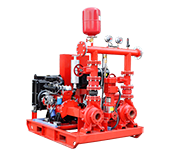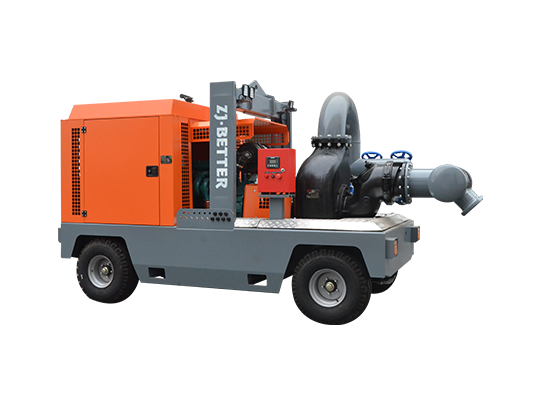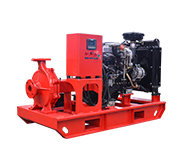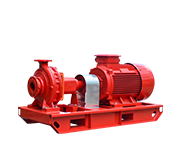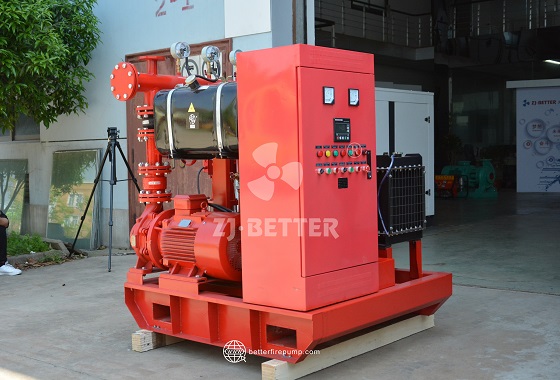In this article, we will analyze ten key advantages of modern fire pumps, focusing on how their flow rate and head height can be evaluated and optimized to meet the needs of different fire protection scenarios.
1.High-Flow Design for Diverse Fire Suppression Needs
Modern fire pumps are designed with high-flow capabilities, ensuring that large volumes of water can be delivered rapidly during fire emergencies. Whether for industrial complexes, commercial buildings, or municipal fire systems, they guarantee a steady and abundant water supply. In large-scale fires, rapid water discharge is crucial to containing the flames and minimizing property damage.
The high-flow design guarantees an abundant water supply for firefighting in industrial, commercial, and municipal settings, ensuring rapid fire suppression and safety.
2.High Head Height for Reliable Water Pressure in Tall Buildings
With adjustable head heights, these pumps are ideal for fire protection in high-rise buildings, ensuring that water can be delivered to the uppermost floors without pressure loss. In cases where long-distance water transportation is required, high-head fire pumps maintain a steady flow and ensure adequate pressure, making them essential for urban and industrial firefighting applications.
Designed for high-rise buildings and long-distance water transport, high-head fire pumps maintain steady water pressure, ensuring reliable firefighting performance in multi-story structures.
3.Powerful Engine Ensuring Continuous Water Supply
Fire pumps are powered by high-performance electric motors or diesel engines, offering uninterrupted operation even in power outage scenarios. In areas where electricity supply is unstable or unavailable, diesel-driven fire pumps become the primary choice, ensuring that fire suppression efforts are not hindered due to lack of power.
Equipped with high-performance electric or diesel engines, these fire pumps guarantee uninterrupted water supply, ensuring reliable operation even during power failures.
4.Intelligent Control System for Real-Time Monitoring and Adjustments
Advanced smart control panels allow real-time monitoring of water pressure, flow rate, and operational status. These systems enable automatic adjustments, ensuring optimal performance while reducing the need for manual intervention. With automated start-stop functions, remote monitoring, and fault alarms, fire safety is further enhanced.
Smart control panels monitor real-time parameters, automatically adjusting settings for optimal performance, with remote control and fault detection capabilities for enhanced safety.
5.Energy-Efficient Design for Cost Reduction
With optimized hydraulic structures and impeller designs, fire pumps minimize energy consumption while maximizing performance. By intelligently adjusting operational parameters, they reduce power wastage, lower operational costs, and promote environmentally friendly fire protection solutions.
Optimized impeller and pump designs improve energy efficiency, reducing power consumption and operational costs while ensuring an environmentally sustainable fire protection system.
6.Corrosion-Resistant, Durable Construction
Built with high-strength materials such as stainless steel and cast iron, modern fire pumps are resistant to corrosion, high temperatures, and harsh environments. Special coatings further enhance resistance to rust and chemical exposure, ensuring long-term durability even in extreme industrial settings.
Manufactured with stainless steel and cast iron, these fire pumps resist corrosion, extreme temperatures, and harsh environments, ensuring long-lasting and reliable operation.
7.Multi-Stage Pump Design for Enhanced Pressure and Flow Stability
A multi-stage pump structure enhances both water pressure and flow stability, making these pumps ideal for high-rise fire protection and industrial firefighting systems. This design optimizes efficiency while maintaining a steady water output, reducing energy consumption while improving performance.
The multi-stage pump design delivers high-pressure, stable water flow, making it ideal for skyscraper fire protection and large industrial applications.
8.Rapid Startup for Immediate Emergency Response
Equipped with automatic start functions, fire pumps can be instantly activated upon detecting a fire signal. The ability to quickly supply water within seconds greatly reduces fire response time, ensuring that suppression efforts begin without delay. This feature is critical for fire safety in any environment.
Automatic startup ensures fire pumps begin operation within seconds of fire detection, significantly reducing response time and increasing firefighting efficiency.
9.Reliable Operation in Extreme Environments
Fire pumps undergo rigorous environmental testing, ensuring stable performance under high temperatures, extreme cold, humidity, and corrosive conditions. These features make them suitable for diverse global environments, including desert regions, coastal areas, and industrial facilities with chemical exposure risks.
Designed to withstand extreme temperatures, humidity, and corrosive environments, fire pumps ensure consistent and reliable performance in any global setting.
10.Easy Maintenance with Advanced Diagnostics
With a compact design, these fire pumps are easy to install and maintain, reducing downtime and repair costs. Self-diagnosing systems detect operational faults in advance, allowing for proactive maintenance and preventing unexpected failures that could impact firefighting readiness.
Compact and easy to maintain, fire pumps feature self-diagnostic systems that detect faults early, minimizing downtime and ensuring continuous operational readiness.
When selecting a fire pump, flow rate and head height are critical factors that determine its effectiveness in firefighting scenarios. By choosing a high-performance pump with powerful engines, smart controls, energy efficiency, and durability, fire protection systems can be optimized for high-rise buildings, industrial facilities, and municipal fire services.
Modern fire pumps not only offer strong water delivery capabilities but also incorporate intelligent features, corrosion resistance, and rapid emergency response, ensuring that fire safety is enhanced across various applications. Proper evaluation of flow rate and head height is essential for maximizing firefighting efficiency, ultimately safeguarding lives and property.
Choosing the right fire pump with optimized flow rate and head height ensures reliable firefighting performance. Advanced features such as smart controls, energy efficiency, and durable construction enhance safety in high-rise buildings, industrial plants, and municipal fire protection systems.

